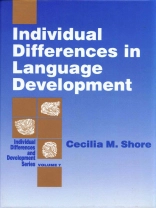Do all children learn language in the same way? Is the apparent ‘fast’ vs. ‘slow’ language learning rate among children a reflection of the individual child′s approach to language acquisition? This volume explores the importance that individual differences have in acquiring language and challenges some of the widely held theories of linguistic development. Focusing on children ages one to three, the author describes characteristic differences in terms of vocabulary, grammatical, and phonological development, and considers whether distinctive ‘styles’ of language development can be defined. In addition, the social and cognitive influences that can explain these differences are examined. The book concludes with a look at new language theories such as ecological, chaos, and connectionist approaches and considers what individual differences in development can tell us about the mechanisms of language development. Individual Differences in Language Development is invaluable for professionals and researchers in developmental psychology, family studies, education, psychology, and communication. ‘Cecilia M. Shore puts forward an alternative theory on differences in language development and offers an important message on the significance of context in children′s early language acquisition. The principal theme has significant implications for further research as well as practical implications for teacher trainers, teachers and parents.’ –Durante′s ‘Cecilia M. Shore writes in a warm and engaging style. . . . It serves her purpose well: to put across complex ideas in a clear and unforgettable form. . . . The content is right on target. Shore covers all the relevant issues in this complex area, and her review is right up to date.’ –Elizabeth Bates, Professor of Psychology and Professor of Cognitive Science, University of California, San Diego
Зміст
Introduction
The Importance of Differences in Language Development
Characterizing the Nature of the Differences
Are There Styles of Language Development?
Explanations for Individual Differences in Language Development
Conclusions and Future Directions












